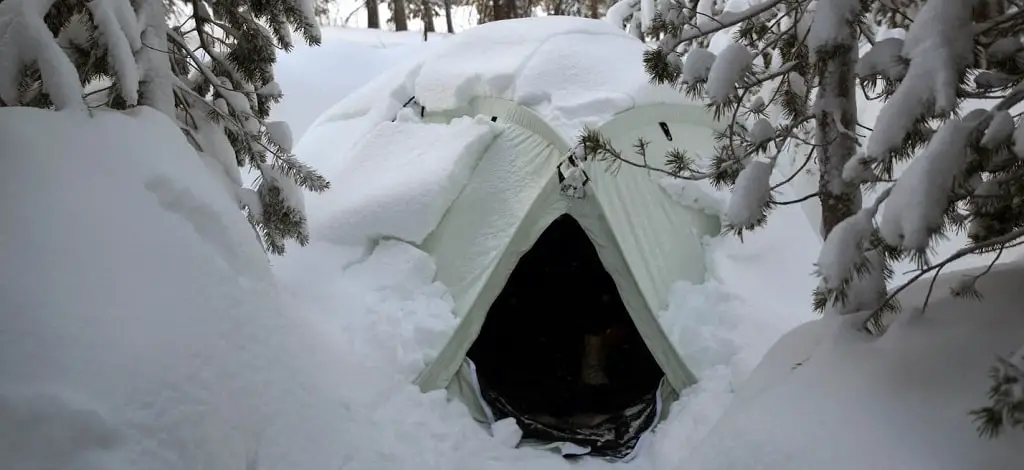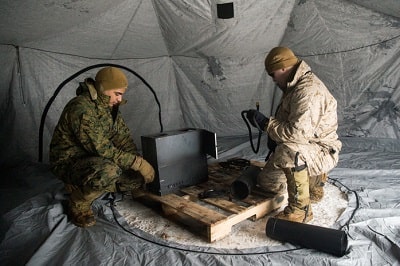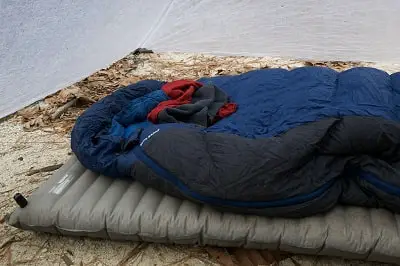Tents are probably among the most crucial gear you will be taking along to the wild. When you are facing some cold conditions, it is essential that you get yourself a proper sleeping bag or perhaps even a liner. Still, in severe cases, these might not be enough. Instead of investing a vast amount of money in better equipment, there are a few ways to elevate the temperature inside. What is the best way to heat a tent while camping? Well, let’s dive right into it.

These are among the best ways to heat a tent quickly and safely:
- Dig a few holes inside your tent and place some hot rocks from your campfire inside those. Cover the stones with soil so that you don’t get burned.
- Use a tent space heater which doesn’t produce carbon monoxide.
- Heat up your tent with a candle lantern (up to 15 degrees).
- Place a bottle with hot water next to your sleeping bag.
- Invest in a sleeping bag which features high-temperature ratings.
- Use a smaller tent that will heat faster and more quickly.
- Eat a decent meal before going to sleep.
1. Hot Stones And Sand (or Socks)
Using hot stones to heat your tent can be a little tricky, but done right, it can be very useful and safe. Besides, while some techniques might not be too appropriate when left unattended, hot stones do not pose the same challenge.
It is possible that you are camping on a beach, or merely pitched your tent in the sand. This can give you an excellent chance to keep your tent warm since you only need some stones to get started. On a fire, you should place about 15 to 20 stones until they heat up.
Note that the stones may take a while to heat up, but that also means that they will generate heat for you for much longer. You also need to keep turning the stones around so that they get adequately heated. You will know that the rocks have heated up to a sufficient degree when they become a little too hot to the touch.
After that, you should dig a hole about a foot deep in the sand, and then place the stones inside and cover them with sand. After you place a tent over this hole, it will heat up due to the heat in the rocks for much of the night.
It is essential that the hole is of appropriate depth, and that you use sand rather than other kinds of material. A shallow dig could result in the posing the risk of burning your tent or the things in it, while a hole that is too deep might make the rocks incapable of generating enough heat to keep the tent warm.
Furthermore, sand is vital since it lets temperature to rise from the rocks more a lot more smoothly. Soil does not have a similar effect. In case you don’t have sand or would prefer an alternative method, you can get some socks.
After the rocks are heated up, you should put socks on your hand and then get the stones and then turn the socks inside out and wrap the stones in them. You can then place the rocks at strategic points around the tent, and you can expect to enjoy a warmer tent.
2. Tent Space Heater
These days, there are space heaters explicitly made for tents. However, these devices are safe, even though tents have such small spaces and flammability might be a concern.
However, these gadgets are made with all these considerations in mind. Therefore, these space heaters are truly magical, and you can get a heater from a reputable brand to enjoy the very best tent heating experience you can find.
One of the benefits of a tent space heater is that you can keep it running all night, which should come in handy in case the weather is too cold, and you need to stay warm throughout the night.
Otherwise, if the tent gets too hot, you can keep the space heater on for an hour or so before going to bed. The heat that the device will have generated by then could be enough to keep you going till morning.
One of the benefits of a space heater is that it does not result in any open flames, which can be a considerable health hazard since fires can start quickly.

With an electric heater, you can choose among halogen, radiant, and fan-based heaters. With any of these heating options, you avoid the risks that also comes with using coals, which can result in carbon monoxide poisoning.
However, some heaters should not be left unattended. For instance, the catalytic heater, which is meant to be used inside a tent should be allowed to run when you are still awake, and then shut off when it’s time to get to bed, and you can put them back on in the morning after waking up.
Still, you should be cautious with your use of portable heaters. For the sake of general safety, these heaters should be turned off before bed as they can pose significant risks when unattended for long periods. In the case of gas heaters, their use should be in well-ventilated spaces.
While at it, you can make sure that you have in place a carbon monoxide alarm in your tent so that you can know when the breathing situation in your tent is starting to get out of hand due to the heating method you are using to keep it warm.
3. Candle Lantern
This tent heating method can be useful in cases where the weather is not too cold or too windy. Among the benefits of this method is the fact that you can avoid the dangers of using propane and electric heaters. A candle lantern can increase the temperature in your tent by up to 15 degrees.
However, since a candle lantern has an open flame, this tent heating method requires quite a bit of care to avoid any hazards. For instance, you should never sleep with a candle lantern still lit. Therefore, you should light the lamp some hours before bed so that the tent will be warm before you get into bed.
4. Hot Water In A Bottle
You can heat water and then put it in a non-plastic bottle, then put it on the lower side of your sleeping bag close to your feet. The heat it generates will usually be diffused upwards, and it will keep your whole body warm.
You should be careful not to place the hot water bottle next to your torso, as this can be dangerous to your health. Hot water can heat up your organs excessively, and this can even cause harm to your kidneys.
For the sake of safety, you should not drink hot water after it has been put in a plastic bottle. Such water is usually not safe for drinking since heated plastic releases some particles that can harm your health.
5. Get a The Right Sleeping Bag
If you know that you will be camping in a frigid region, then getting a sleeping bag which helps you stay warmer can help you avoid cold and the need for alternative heating methods.
Sleeping bags have ratings, and a sleeping bag that is rated for zero degrees will keep you warmer as you sleep in your tent.
You can also get a sleeping bag liner made of fleece that can increase the temperature of your sleeping bag by about ten degrees. Some sleeping bags have pretty good ratings in this regard, and they can help you stay warm in your tent despite the chilly weather.

A massive benefit of getting the warmth you need through an appropriate sleeping bag is that it will keep you warm all night. Additionally, this method of staying warm does not come with any hazards since it does not cause the emission of dangerous gases or the possibility of starting a fire.
Still, a suitable sleeping bag will only help solve some of the heating issues your tent might be having. Therefore, you might need to use an additional tent heating technique to get the temperature you desire, although not as desperately as you would while using a regular sleeping bag.
6. Use a Smaller Tent
The bigger the tent, the harder it is to keep warm. However, with a smaller canvas, the heat the campers generate might be enough to keep it warm. Additionally, any tent heating methods used on a smaller tent are likely to be more effective since there is a smaller tent to heat up.
Therefore, as you buy a tent, you can consider a smaller size if you know that heating the tent will be a regular concern for you. Of course, you have to take into consideration your needs as far as the need for tent space goes.
Otherwise, there is also a way you can have the best of both worlds by getting a large enough tent that can be opened partially in order to take less space.
Another option is choosing a tent material that has a reputation for preserving heat. Generally, canvas and polycotton are considered excellent options in this regard as they help minimize heat loss considerably.
7. Eat Appropriately
With the right meals, you might never notice that the weather is cold, and you should sleep comfortably in your tent. Before bedtime, you should have a substantial hot meal, and your body will be sufficiently warm throughout the night. You can also take a hot beverage before bed.
However, you should be careful not to consume too many liquids, as this can get counterproductive when you start waking up too often in the middle of the night to pee.
Every time you open the tent and also expose your body to the cold temperatures outside, you make your tent less comfortable to stay in since the temperatures will keep going down.
That said, whenever the urge to urinate comes, you should not hold it in as that can make you have poor quality sleep and even cause you some health problems over time.
Some people also have a ’yellow bottle’ in their tents which they use to pee without having to step outside the tent. If that option can work for you, you can always give it a try.
What Stones Hold Heat Best?
Using a few hot rocks to heat your tent is my favorite way to go. This way you don’t have to spend a lot of money on heaters and you, more importantly, do not rely on electricity.
Still, not all stones hold heat the same. In fact, that ability depends on two main things – the density of the rock and its specific heat value. Denser rocks with a higher specific heat tend to heat up slowly and remain hot in cold environments.
If in reach, I would say you should use basalt, limestones, granite or marble to elevate the temperature in your tent. Consider that you must have a decent campfire with a significant flame that burns for quite some time to achieve that.
On that topic, make sure that you take an in-depth look in my article on how to make a campfire burn all night. I’ve gathered there all the tips that would allow you to create a long-standing fire which would keep you warm and heat your stones properly.
What Stones Shouldn’t I Use to Heat my Tent With?
Making your tent warmer by using hot stones makes a lot of sense, although there are a few kinds you should avoid. The phenomenon I am referring to is exploding campfire rocks, which most of you probably heard of.
If you haven’t, take a look at that article I’ve written – you might get a better understanding of how to avoid these. Many times stones tend to pop-up once heat, especially when circling your campfire.
In short, when temperature builds up the pressure inside the stone elevates and in some circumstances cause the rock to explode. If you are using the rocks around the beach, make sure you pick those who are far away from the water.
Smooth stones tend to have water molecules inside which evaporate from a specific temperature and compromises the stone stability.
Also, the rock should feature a solid form instead of a layered one. For that, I suggest that you avoid using sandstones (even though they lose heat quite slow) – this type tends to explode.
Does Water Retain Heat?
Water features a specific heat of 4.18. For comparison, dry aris features 1.01 – that means water tend to retain heat four times better than air.
If you continue that thought – your tent would probably maintain warm for a more extended period when you are using water bottles instead of a heater (when you turn it off before going to sleep).
The specific heat of a material describes in numbers how much energy you have to put into elevating 100 grams of it in a single degree. It is still right when the water reaches high temperatures – even those that would kill bacteria and viruses after a while.

This also goes the other way around – the harder it is to heat the object, the slower it drops temperatures. Nevertheless, water bottles are usually a one-way street; once they are cold, they won’t do you any good.
On the other hand, once temperatures drop during nighttime, you can merely turn up the heater and gain some warmth. Consider these two ways of thoughts and gather yourself a solid strategy to go with.
Conclusions
Heating your tent is essential when facing cold conditions, especially during winter. You could invest in a proper sleeping bag, although the additional steps I’ve mentioned above would probably do the trick as well.
Make sure that you use the right rocks when using the first method – otherwise, they might pop up in the heating process. That would probably be my favorite way to go, although you can away combine a few techniques for better results.
I hope my article had shed some light on how you should warm up your tent. If it hadn’t, or whether you have any new insights – let me know all about them by leaving a comment below!

